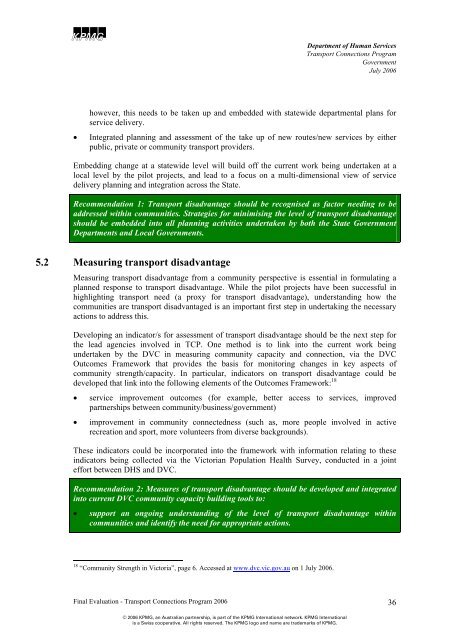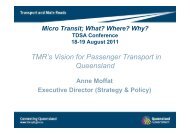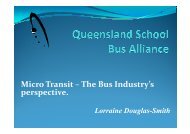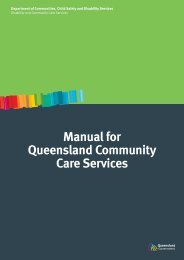Transport Connections Evaluation Report - TDSA
Transport Connections Evaluation Report - TDSA
Transport Connections Evaluation Report - TDSA
Create successful ePaper yourself
Turn your PDF publications into a flip-book with our unique Google optimized e-Paper software.
ABCD<br />
Department of Human Services<br />
<strong>Transport</strong> <strong>Connections</strong> Program<br />
Government<br />
July 2006<br />
however, this needs to be taken up and embedded with statewide departmental plans for<br />
service delivery.<br />
• Integrated planning and assessment of the take up of new routes/new services by either<br />
public, private or community transport providers.<br />
Embedding change at a statewide level will build off the current work being undertaken at a<br />
local level by the pilot projects, and lead to a focus on a multi-dimensional view of service<br />
delivery planning and integration across the State.<br />
Recommendation 1: <strong>Transport</strong> disadvantage should be recognised as factor needing to be<br />
addressed within communities. Strategies for minimising the level of transport disadvantage<br />
should be embedded into all planning activities undertaken by both the State Government<br />
Departments and Local Governments.<br />
5.2 Measuring transport disadvantage<br />
Measuring transport disadvantage from a community perspective is essential in formulating a<br />
planned response to transport disadvantage. While the pilot projects have been successful in<br />
highlighting transport need (a proxy for transport disadvantage), understanding how the<br />
communities are transport disadvantaged is an important first step in undertaking the necessary<br />
actions to address this.<br />
Developing an indicator/s for assessment of transport disadvantage should be the next step for<br />
the lead agencies involved in TCP. One method is to link into the current work being<br />
undertaken by the DVC in measuring community capacity and connection, via the DVC<br />
Outcomes Framework that provides the basis for monitoring changes in key aspects of<br />
community strength/capacity. In particular, indicators on transport disadvantage could be<br />
developed that link into the following elements of the Outcomes Framework: 18<br />
• service improvement outcomes (for example, better access to services, improved<br />
partnerships between community/business/government)<br />
• improvement in community connectedness (such as, more people involved in active<br />
recreation and sport, more volunteers from diverse backgrounds).<br />
These indicators could be incorporated into the framework with information relating to these<br />
indicators being collected via the Victorian Population Health Survey, conducted in a joint<br />
effort between DHS and DVC.<br />
Recommendation 2: Measures of transport disadvantage should be developed and integrated<br />
into current DVC community capacity building tools to:<br />
• support an ongoing understanding of the level of transport disadvantage within<br />
communities and identify the need for appropriate actions.<br />
18 “Community Strength in Victoria”, page 6. Accessed at www.dvc.vic.gov.au on 1 July 2006.<br />
Final <strong>Evaluation</strong> - <strong>Transport</strong> <strong>Connections</strong> Program 2006<br />
36<br />
© 2006 KPMG, an Australian partnership, is part of the KPMG International network. KPMG International<br />
is a Swiss cooperative. All rights reserved. The KPMG logo and name are trademarks of KPMG.









